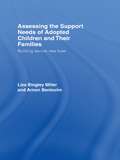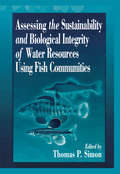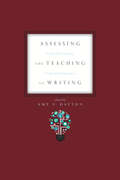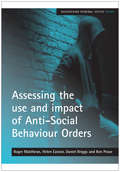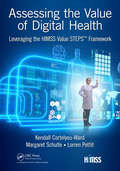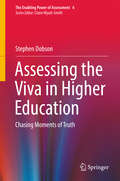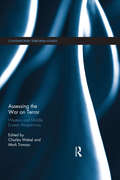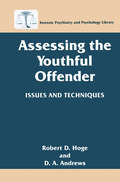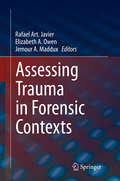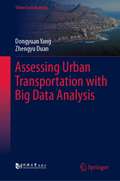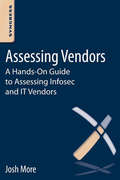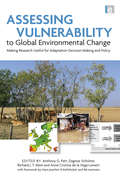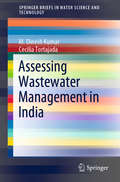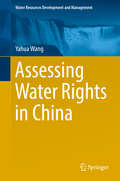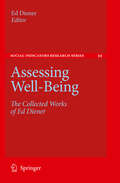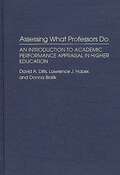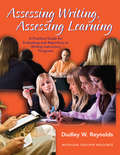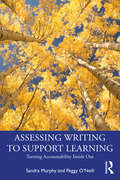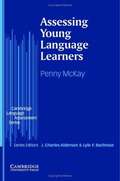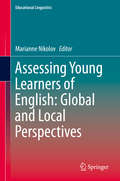- Table View
- List View
Assessing the Support Needs of Adopted Children and Their Families: Building Secure New Lives
by Liza Bingley Miller Arnon BentovimWritten in consultation with a range of experts, clinicians and practitioners as well as adoptive children, families and birth relatives, this book gives helpful guidance on making evidence-based assessments and planning successful adoption support. Key features include: a discussion of the main themes of adoption and pointers for practice in relation to the Assessment Framework a guide to the use of evidence-based approaches to assessment, including the tools commissioned by the Department of Health and the Department for Education a model for analysis and planning, and planning support and interventions an investigation of the source, range and value of support services and interventions that can promote the wellbeing of adopted children, their adoptive families and birth relatives. Packed with practical advice, case examples and models of good practice, this book is invaluable for social workers and managers involved with the adoption process and the well-being of children and families. It is also essential reading for social work students learning about working with children and families.
Assessing the Sustainability and Biological Integrity of Water Resources Using Fish Communities
by Thomas P. SimonThis book examines the application of fish community characteristics to evaluate the sustainability and biological integrity of freshwaters. Topics include perspectives on use of fish communities as environmental indicators in program development, collaboration, and partnership forming; influence of specific taxa on assessment of the IBI; regional applications for areas where the IBI had not previously been developed; and specific applications of the IBI developed for coldwater streams, inland lakes, Great Lakes, reservoirs, and tailwaters.
Assessing the Sustainability and Biological Integrity of Water Resources Using Fish Communities
by Thomas P. SimonThis book examines the application of fish community characteristics to evaluate the sustainability and biological integrity of freshwaters. Topics include perspectives on use of fish communities as environmental indicators in program development, collaboration, and partnership forming; influence of specific taxa on assessment of the IBI; regional applications for areas where the IBI had not previously been developed; and specific applications of the IBI developed for coldwater streams, inland lakes, Great Lakes, reservoirs, and tailwaters.
Assessing the Teaching of Writing: Twenty-First Century Trends and Technologies
by Amy E. DaytonAlthough fraught with politics and other perils, teacher evaluation can contribute in important, positive ways to faculty development at both the individual and the departmental levels. Yet the logistics of creating a valid assessment are complicated. Inconsistent methods, rater bias, and overreliance on student evaluation forms have proven problematic. The essays in Assessing the Teaching of Writing demonstrate constructive ways of evaluating teacher performance, taking into consideration the immense number of variables involved. Contributors to the volume examine a range of fundamental issues, including the political context of declining state funds in education; growing public critique of the professoriate and demands for accountability resulting from federal policy initiatives like No Child Left Behind; the increasing sophistication of assessment methods and technologies; and the continuing interest in the scholarship of teaching. The first section addresses concerns and advances in assessment methodologies, and the second takes a closer look at unique individual sites and models of assessment. Chapters collectively argue for viewing teacher assessment as a rhetorical practice. Fostering new ways of thinking about teacher evaluation, Assessing the Teaching of Writing will be of great interest not only to writing program administrators but also to those concerned with faculty development and teacher assessment outside the writing program.
Assessing the use and impact of Anti-Social Behaviour Orders (Researching Criminal Justice series)
by Roger Matthews Helen EastonAnti-Social Behaviour Orders (ASBOs) have become the main sanction for dealing with anti-social behaviour in the UK. This book provides one of the first assessments of this sanction, which has become widely used but remains extremely controversial. The report is based on detailed interviews with ASBO recipients, practitioners and community representatives in areas affected by anti-social behaviour. Examining its use and impact from these various perspectives, the book assesses the effects of ASBOs on the behaviour and attitudes of recipients as well as examining the various issues which arise in relation to their implementation. The report should be read by academics and students who want to make sense of ASBOs, practitioners who are involved in implementing them as well as policy makers who are responsible for designing this sanction. It will also be of interest to all those who have an interest in addressing the issue of anti-social behaviour.
Assessing the Value of Digital Health: Leveraging the HIMSS Value STEPS™ Framework (HIMSS Book Series)
by Kendall Cortelyou-Ward Margaret Schulte Lorren PettitHIMSS set out to develop a dynamic framework by which to easily catalogue the varied beneficial evidences of digital health. From this effort, HIMSS introduced to the market the HIMSS Value STEPS™ framework. This book will leverage the HIMSS Value STEPS™ model to identify and define the expressions of value the use of health IT systems can yield per the following domains: Satisfaction, Treatment/Clinical, Electronic Secure Data, Patient Engagement and Population Health, and Savings. Using this framework, HIMSS has developed a collection of over 2,000 cases reflecting the value that hospitals, health systems and other providers have experienced following implementation of their electronic health record and/or other IT-related applications. The more than 17,000 value statements that have been extracted from the 2,000+ case articles have been classified within 85 Standard Value Standard (SVS) within the five STEPS domains. The book will describe the STEPS model to demonstrate the impact of health IT in healthcare organizations, and the quality of care and overall financial and operational performance improvements that have been achieved.
Assessing the Value of Digital Health: Leveraging the HIMSS Value STEPS™ Framework (HIMSS Book Series)
by Kendall Cortelyou-Ward Margaret Schulte Lorren PettitHIMSS set out to develop a dynamic framework by which to easily catalogue the varied beneficial evidences of digital health. From this effort, HIMSS introduced to the market the HIMSS Value STEPS™ framework. This book will leverage the HIMSS Value STEPS™ model to identify and define the expressions of value the use of health IT systems can yield per the following domains: Satisfaction, Treatment/Clinical, Electronic Secure Data, Patient Engagement and Population Health, and Savings. Using this framework, HIMSS has developed a collection of over 2,000 cases reflecting the value that hospitals, health systems and other providers have experienced following implementation of their electronic health record and/or other IT-related applications. The more than 17,000 value statements that have been extracted from the 2,000+ case articles have been classified within 85 Standard Value Standard (SVS) within the five STEPS domains. The book will describe the STEPS model to demonstrate the impact of health IT in healthcare organizations, and the quality of care and overall financial and operational performance improvements that have been achieved.
Assessing the Viva in Higher Education: Chasing Moments of Truth (The Enabling Power of Assessment #6)
by Stephen DobsonThis book makes the case for a revival in interest in the viva. As an oral assessment of a treatise or dissertation or of a student’s performance in art or dance the viva has a long history dating back to the time of the Greeks. It can be found today in the form of professional, vocational and academic vivas, where a judgment of oral performance is required to gain entry into a profession or community of scholars.In a time when there are scandals about students selling essays to other students, the viva provides a fertile ground for probing the student to see whether they are in fact the authors of the work being assessed and know its content and how to think cognitively or otherwise.Given that we actually know so little about the viva, the book theorises the viva based on a unique sample of vivas that have been filmed or in which the author himself has been participant, and discusses why its format is so different in Anglo-Saxon languages and Latin and other languages.The book offers educational policy-makers and examiners a trade-off between arguments in support of the viva and the demand for other, ever more cost-effective forms of assessment as the numbers of both undergraduate and postgraduate students threaten to increase. It also argues that with demand in the labour market for qualified graduates who are better equipped with transferable skills, such as the ability to communicate complex ideas verbally in a competent, well-argued fashion and not merely through the use of rhetoric, what appear to be cost-effective forms of assessment in the short run (e.g. written exams with standardised questions or multiple choice) may actually in the long run be of less value if we are investing in a future workforce with so-called 21st century communication skills.If the viva were abandoned, the student would be robbed of the opportunity to stage a defence.
Assessing the War on Terror: Western and Middle Eastern Perspectives (Contemporary Terrorism Studies)
by Charles Webel Mark TomassThis volume is a collection of articles that critically examine the efficacy, ethics, and impact of the War on Terror as it has evolved since 9/11. During the decade and a half of the Global War on Terror (GWOT), numerous books have considered the political, psychosocial, and economic impacts of terrorism. However, there has been little systematic effort to examine the effectiveness of the GWOT in achieving its goals. Furthermore, there is virtually nothing that presents a comparative analysis of the GWOT by the people most directly affected by it—citizens and scholars from conflict zones in the Middle East. There is, therefore, great need for a book that analyzes the strategies, tactics, and outcomes of the GWOT and that also presents facts and ideas that are missing or underrepresented in the dominant public narratives. The contributions in this volume were chosen to specifically address this need. In doing so, it uniquely provides not only Western perspectives of the GWOT, but also importantly includes perspectives from the Middle East and those most directly affected by it, including contributions from scholars and policy makers. Overall, the contributions demonstrate how views differ based on geographical location, and how views have changed during the course of the still-evolving War on Terror. The book will be of much interest to students and scholars of terrorism and counter-terrorism, foreign policy, Middle Eastern politics, security studies and IR, as well as policy makers.
Assessing the War on Terror: Western and Middle Eastern Perspectives (Contemporary Terrorism Studies)
by Charles Webel Mark TomassThis volume is a collection of articles that critically examine the efficacy, ethics, and impact of the War on Terror as it has evolved since 9/11. During the decade and a half of the Global War on Terror (GWOT), numerous books have considered the political, psychosocial, and economic impacts of terrorism. However, there has been little systematic effort to examine the effectiveness of the GWOT in achieving its goals. Furthermore, there is virtually nothing that presents a comparative analysis of the GWOT by the people most directly affected by it—citizens and scholars from conflict zones in the Middle East. There is, therefore, great need for a book that analyzes the strategies, tactics, and outcomes of the GWOT and that also presents facts and ideas that are missing or underrepresented in the dominant public narratives. The contributions in this volume were chosen to specifically address this need. In doing so, it uniquely provides not only Western perspectives of the GWOT, but also importantly includes perspectives from the Middle East and those most directly affected by it, including contributions from scholars and policy makers. Overall, the contributions demonstrate how views differ based on geographical location, and how views have changed during the course of the still-evolving War on Terror. The book will be of much interest to students and scholars of terrorism and counter-terrorism, foreign policy, Middle Eastern politics, security studies and IR, as well as policy makers.
Assessing the Youthful Offender: Issues and Techniques (Forensic Psychiatry and Psychology Library)
by Robert D. Hoge D.A. AndrewsOur society's preoccupation with crime and fear of crime appears to have shifted its focus to the juvenile offender. Both electronic and print media continuously warn us that juvenile offenders are increasingly younger and more virulent. The demographics of our population suggest that there will only be more juvenile offenders to fear in the near future. All of these concerns arise in a social climate that is characterized by an ever increasing demand for stronger retributive measures against the offender. The belief that only harsh justice will protect us from the ravages of juveniles has become dominant. Increasingly, perceptions and politics, rather than scientific data, dominate policy making with regard to youthful offenders. In Assessing the Youthful Offender: Issues and Techniques, Robert D. Hoge and D. A. Andrews make a restrained, rational, and ultimately persuasive argu ment for the use of standardized psychological assessments in the effective management of youth within juvenile justice systems. They clarify how what we already know about the cause and management of youthful criminal activity can be incorporated into standardized testing and that the information obtained from testing can improve the administration of criminal justice. Moreover, this informa tion is useful whatever the theoretical biases of those who administer the justice system. The efficiency of policies of either retribution, deterrence, or rehabilitation is only enhanced by reliance on data.
Assessing Trauma in Forensic Contexts
by Rafael Art. Javier Elizabeth A. Owen Jemour A. MadduxThis book examines the different ways that trauma is involved in the lives of those who interact with the justice system, and how trauma can be exacerbated in legal settings. It includes both victims and perpetrators in providing a perspective on trauma in general, and a framework that will guide those who evaluate and treat individuals in forensic settings. Comprehensive in scope, it covers key areas such as developmental issues, emotions, linguistic and communication difficulties, and special populations such as veterans, immigrants, abused women, incarcerated individuals, and children. The main objective of this book is to bring trauma to the fore in conducting forensic evaluations in order to understand these cases in greater depth and to provide appropriate interventions for a range of problems.“This masterful book, edited by Rafael Art. Javier, Elizabeth Owen and Jemour A. Maddux, is a refreshing, original, and thoughtful response to these needs, demonstrating – beyond any doubt – why lawyers and forensic mental health professionals must be trauma-informed in all of their relevant work.” –Michael L. Perlin, Esq., New York Law School
Assessing Urban Transportation with Big Data Analysis (Urban Sustainability)
by Dongyuan Yang Zhengyu DuanThis book chiefly focuses on urban traffic, an area supported by massive amounts of data. The application of big data to urban traffic provides strategic and technical methods for the multi-directional and in-depth observation of complex adaptive systems, thus transforming conventional urban traffic planning and management methods. Sharing valuable insights into how big data can be applied to urban traffic, it offers a valuable asset for information technicians, traffic engineers and traffic data analysts alike.
Assessing Vendors: A Hands-On Guide to Assessing Infosec and IT Vendors
by Josh MoreAssessing vendors is a tricky process. Large and regulated organizations are forced to demonstrate due diligence in vendor assessment, but often do not know how to do this. This results in a great deal of busywork being required by both the vendors and the organizations. Smaller organizations don't know what to look for and, as a result, often wind up selecting based on price instead of value. This results in service failures and vendors that just milk their customers for as long as they can. Assessing Vendors shows you how to walk the line between under- and over-assessing, so decisions can be made on sufficient data without wasting time, digging too deeply, or making decisions too quickly. This hands-on guide will show you how to use an iterative approach to vendor analysis, so you can rapidly filter out the vendors that are clear failures and then select likely winners. It will then show you how to do progressively deeper dives into the likely winners so you can select a preferred vendor. Finally, you will learn how to negotiate with your preferred vendor to get reasonable prices and services. Provides an iterative approach to vendor assessment, showing you how to make decisions on sufficient data without wasting time Includes checklists to help you navigate the decision-making process, while considering all the important factors needed to make a sound decision Helps you understand and evaluate vendors based on key concepts such as performance criteria, functional testing, production, and priceProvides an iterative approach to vendor assessment, showing you how to make decisions on sufficient data without wasting timeIncludes checklists to help you navigate the decision-making process, while considering all the important factors needed to make a sound decisionHelps you understand and evaluate vendors based on key concepts such as performance criteria, functional testing, production, and price
Assessing Vulnerability to Global Environmental Change: Making Research Useful for Adaptation Decision Making and Policy
by Richard J. Klein Anthony G. PattAssessing the vulnerability of human populations to global environmental change, particularly climate change, is now the main imperative of research and international action. However, much of the research into vulnerability is not designed to feed directly into decision making and policy, creating a gap between the knowledge created by researchers and what is required by decision makers. This book seeks to rectify this problem and bridge the gap. It discusses vulnerability as the central theme and brings together many different applications from disaster studies, climate change impact studies and several other fields and provides the most comprehensive synthesis of definitions, theories, formalization and applications to date, illustrated with examples from different disciplines, regions and periods, and from local through to regional, national and international levels. Case study topics cover sea level rise, vulnerability to changes in ecosystem services, assessing the vulnerability of human health and 'double exposure' to climate change and trade liberalization amongst other issues. Research outcomes stress that science-policy dialogues must be transparent to be effective and concentrate on a mutual understanding of the concepts used. A key research finding is that the most useful information for decision makers is that which shows the separate causes and drivers of vulnerability, rather than presenting vulnerability in an aggregated form. The book concludes with a unifying framework for analysing integrated methodologies of vulnerability assessment and guiding how research and policy can be linked to reduce vulnerability.
Assessing Vulnerability to Global Environmental Change: Making Research Useful for Adaptation Decision Making and Policy
by Richard J. Klein Anthony G. PattAssessing the vulnerability of human populations to global environmental change, particularly climate change, is now the main imperative of research and international action. However, much of the research into vulnerability is not designed to feed directly into decision making and policy, creating a gap between the knowledge created by researchers and what is required by decision makers. This book seeks to rectify this problem and bridge the gap. It discusses vulnerability as the central theme and brings together many different applications from disaster studies, climate change impact studies and several other fields and provides the most comprehensive synthesis of definitions, theories, formalization and applications to date, illustrated with examples from different disciplines, regions and periods, and from local through to regional, national and international levels. Case study topics cover sea level rise, vulnerability to changes in ecosystem services, assessing the vulnerability of human health and 'double exposure' to climate change and trade liberalization amongst other issues. Research outcomes stress that science-policy dialogues must be transparent to be effective and concentrate on a mutual understanding of the concepts used. A key research finding is that the most useful information for decision makers is that which shows the separate causes and drivers of vulnerability, rather than presenting vulnerability in an aggregated form. The book concludes with a unifying framework for analysing integrated methodologies of vulnerability assessment and guiding how research and policy can be linked to reduce vulnerability.
Assessing Wastewater Management in India (SpringerBriefs in Water Science and Technology)
by M. Dinesh Kumar Cecilia TortajadaThis book highlights the institutional, legal, and policy measures to manage water pollution in India, and discusses how effective they have been in improving the overall quality of the country’s surface and groundwater resources. It also reviews the status of wastewater generation, collection and treatment in urban areas to provide insights into the gaps in wastewater treatment. Further, it offers a detailed analysis of the wastewater treatment systems available and examines the human health impacts of water pollution in the country, as well as the future trajectory of investment in wastewater treatment systems and potential sectors for reuse and recycling of wastewater, briefly assessing the market demand for treated wastewater. Lastly, it investigates the factors influencing the environmental sustainability and economic viability of wastewater treatment as well as future areas of research in the field.
Assessing Water Rights in China (Water Resources Development and Management)
by Yahua WangThis book presents a model for describing the hierarchical concept of China’s water rights structure, one which takes into account pioneering theories on natural resources and environmental institutional economics. It highlights the basic theory of water rights, with a view to helping Chinese policymakers acquire a deeper understanding of water rights and the need for a reform program in the long-term development of water-poor China. To do so, it draws on three main sources: Cheung SNS’s “Economic Explanation”, Douglas C. North’s “New Economic History” and Ray Huang’s “Macro History”.The book makes two essential contributions: it elaborates the hierarchical water governance structure in China, which originated in the Qin Dynasty that unified the country 2000 years ago and has been employed without interruption ever since; further, it constructs a choice model for water governance structures and advances the logic of making structural choices with minimum transaction costs under constraint conditions, while also explaining the inherent nature of China’s choice for the hierarchical structure from the perspectives of management cost and cooperation cost. As such, the book enriches and builds on the theories of the “water governance” school represented by Karl Marx, Karl Wittfogel and Ray Huang, laying the foundation for the further study of water rights theory in contemporary China.
Assessing Well-Being: The Collected Works of Ed Diener (Social Indicators Research Series #39)
by Ed DienerThe Sandvik, Diener, and Seidlitz (1993) paper is another that has received widespread attention because it documented the fact that self-report well-being scales correlate with a number of other methods of measuring the same concepts, such as with reports by knowledgeable “informants” (family and friends), expe- ence sampling measurement, and the memory for good versus bad life events. A single factor was found to underlie measures using different methods, and a n- ber of different well-being self-report measures were found to correlate with the non-self-report measures. Thus, although the self-report measures of well-being are imperfect, and can be in uenced by response artifacts, they have substantial validity as shown by their correlations with measurements based on alternative methods. Whereas the Pavot and Diener article reviewed the Satisfaction with Life Scale, the Lucas, Diener, and Larsen (2003) paper reviews various approaches to assessing positive emotions. As we wrote in the chapter in this volume in which we present new measures, we do not consider any of the existing measures of positive affect to be entirely acceptable for measuring subjective well-being in the affect area, and that is why we have created and validated a new measure.
Assessing What Professors Do: An Introduction to Academic Performance Appraisal in Higher Education (Contributions to the Study of Education)
by D M Bialik David A. Dilts L.J. HaberThis book is a basic treatment of faculty performance appraisal in higher education. It is written for those scholars faced with the need to understand the issues and solutions to the often thorny problems posed by having to judge the performance of their colleagues in teaching, service, research and citizenship. Neophyte administrators, committee members, and those facing evaluation are often perplexed by the range and depth of the questions concerning what constitutes an effective and reasonable performance appraisal system. This book provides answers to the most common of these questions and integrates current thinking from education literature with models of strategic management from business administration.
Assessing Writing, Assessing Learning: A Practical Guide to Evaluating and Reporting on Writing Instruction Programs
by Dudley W ReynoldsThe goals of this resource are broader than many standard books on writing assessment, which focus on evaluating an individual’s ability to create an effective piece of writing for a particular purpose. Assessing Writing, Assessing Learning seeks to support teachers, administrators, program directors, and funding entities who want to make the best use of the resources at their disposal to understand what students are learning and why and then take actions based on what they have learned. It also seeks to provide a common basis for communication among all the interested parties—the writing professionals, the people who identified the need for the program, and the students. The book has sections on planning, tools (different ways of collecting data and links to instruments), and reporting (examples provided). Each section includes a discussion of issues and advice for working through the issue along with numerous examples, plus a list of resources to consult to learn more. The final chapter provides worksheets that may be reproduced and used to help those in charge of setting up and delivering a writing program to think through the issues presented. A glossary of terms is also included.
Assessing Writing to Support Learning: Turning Accountability Inside Out
by Sandra Murphy Peggy O'NeillIn this book, authors Murphy and O’Neill propose a new way forward, moving away from high-stakes, test-based writing assessment and the curriculum it generates and toward an approach to assessment that centers on student learning and success. Reviewing the landscape of writing assessment and existing research-based theories on writing, the authors demonstrate how a test-based approach to accountability and current practices have undermined effective teaching and learning of writing. This book bridges the gap between real-world writing that takes place in schools, college, and careers and the writing that students are asked to do in standardized writing assessments to offer a new ecological approach to writing assessment. Murphy and O’Neill’s new way forward turns accountability inside out to help teachers understand the role of formative assessments and assessment as inquiry. It also brings the outside in, by bridging the gap between authentic writing and writing assessment. Through these two strands, readers learn how assessment systems can be restructured to become better aligned with contemporary understandings of writing and with best practices in teaching. With examples of assessments from elementary school through college, chapters include guidance on designing assessments to address multiple kinds of writing, integrate reading with writing, and incorporate digital technology and multimodality. Emphasizing the central role that teachers play in systemic reform, the authors offer sample assessments developed with intensive teacher involvement that support learning and provide information for the evaluation of programs and schools. This book is an essential resource for graduate students, instructors, scholars and policymakers in writing assessment, composition, and English education.
Assessing Writing to Support Learning: Turning Accountability Inside Out
by Sandra Murphy Peggy O'NeillIn this book, authors Murphy and O’Neill propose a new way forward, moving away from high-stakes, test-based writing assessment and the curriculum it generates and toward an approach to assessment that centers on student learning and success. Reviewing the landscape of writing assessment and existing research-based theories on writing, the authors demonstrate how a test-based approach to accountability and current practices have undermined effective teaching and learning of writing. This book bridges the gap between real-world writing that takes place in schools, college, and careers and the writing that students are asked to do in standardized writing assessments to offer a new ecological approach to writing assessment. Murphy and O’Neill’s new way forward turns accountability inside out to help teachers understand the role of formative assessments and assessment as inquiry. It also brings the outside in, by bridging the gap between authentic writing and writing assessment. Through these two strands, readers learn how assessment systems can be restructured to become better aligned with contemporary understandings of writing and with best practices in teaching. With examples of assessments from elementary school through college, chapters include guidance on designing assessments to address multiple kinds of writing, integrate reading with writing, and incorporate digital technology and multimodality. Emphasizing the central role that teachers play in systemic reform, the authors offer sample assessments developed with intensive teacher involvement that support learning and provide information for the evaluation of programs and schools. This book is an essential resource for graduate students, instructors, scholars and policymakers in writing assessment, composition, and English education.
Assessing Young Language Learners (PDF)
by Penny McKay Lyle F. Bachman J. Charles AldersonIn this book the author builds a comprehensive framework for the assessment of young language learners in both foreign language and second language learning situations. She begins by considering why we need a special book on young learner assessment, and describes the nature of young learner language learning. The assessment approach is task-based and is centred around tasks and techniques suitable for young learners, with particular emphasis on classroom assessment. Oral language assessment, and reading and writing assessment are addressed in separate chapters, as is the large-scale testing of young learners. Underpinned by sound theory, the book is full of practical guidelines, and draws on examples of assessment contexts, issues and practices from around the world. Assessing Young Language Learners was winner of the Kenneth W Mildenberger Prize in 2006.
Assessing Young Learners of English: Global And Local Perspectives (Educational Linguistics #25)
by Marianne NikolovThis volume documents international, national, and small-scale testing and assessment projects of English language education for young learners, across a range of educational contexts. It covers three main areas: age-appropriate ‘can do statements’ and task types for teaching and testing learners between the ages of 6 to 13; innovative approaches to self-assessment, diagnostic testing, self- perception, and computer-based testing; and findings on how young learners perform on vocabulary, listening, speaking, pronunciation, and reading comprehension tests in European and Asian contexts. Early language learning has become a major trend in English language education around the globe. As a result of the spread of teaching English to a growing number of young children, assessment of and for learning have emerged as key issues. In line with this development, there is a clear and emerging need to make early language programs accountable and to assess both the progress children make over time and to quantify their achievement at various stages of development. This volume informs stakeholders about the realistic goals of early language learning, their efficiency, and how much progress children make over time.
